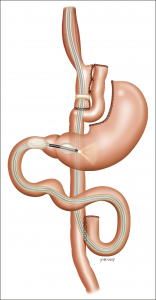What is Push Endoscopy?
Push endoscopy (also referred to as push enteroscopy) is a procedure that allows diagnosis and treatment of diseases in the upper small intestine. Push endoscopy reaches further into the small intestine than the standard upper gastrointestinal endoscopy (also known as esophagogastroduodenoscopy, EGD). Endoscopes for push endoscopy are similar in length to colonoscopes, approximately 200cm and have working channels for diagnostic and therapeutic procedures. After the endoscope is passed into the duodenum, a more rigid overtube is passed over the endoscope to straighten its path. With the overtube in place, the endoscope then can be advanced without coiling in the stomach. The procedure takes about 25 to 45 minutes. You will go home the same day.
Before the procedure begins:
You may be given medicine to help you relax or sleep (sedation). This is given through an IV line placed in a vein in your arm or hand. Your throat may be numbed with a spray or liquid. You will be given a small plastic guard to protect your teeth.
During the procedure:
You will lie on your left side. The tube is placed in your mouth, and it moves down your throat. Air is used to expand your GI (gastrointestinal) tract so the lining can be seen more clearly. The tube is guided down your esophagus. It then goes through your stomach and into your small intestine. Your position may be changed or your healthcare provider may apply pressure over your abdomen, if needed. The tube sends pictures of the GI tract to a screen. The esophagus, stomach, and small intestine are checked. Problems such as bleeding, redness or swelling (inflammation), or growths may be seen. Using tools inserted through the tube, small tissue samples can be taken. In some cases, small growths can be removed. Other treatments, such as those to stop bleeding, may be done. The tube is then removed.
What are the advantages of push endoscopy?
Push endoscopy is a useful procedure for examining and delivering therapy in the small intestine. For example, for patients with intermittently bleeding angiodysplasias (clusters of weakened blood vessels) located in the small intestine beyond the reach of a standard upper endoscope, push endoscopy can be helpful in both diagnosing the bleeding site as well as in stopping the bleeding.
What are the limitations of push endoscopy?
Push endoscopy has its limitations. Its reach is still limited and cannot diagnose lesions in the distal small intestine (intestine closer to the colon). The major risks of push endoscopy are the same as other endoscopic procedures, bleeding and perforation of the intestine, either due to passage of the endoscope or the accompanying therapeutic procedures. Because of the use of an overtube, the risk of perforation probably is increased over the risks of an endoscope alone.
After the procedure:
Your healthcare provider will talk with you afterward about the results. You’ll rest until you are recovered and can safely go home. Have an adult family member or friend drive you. Plan to rest for the remainder of the day.
Recovering at home
You’ll likely feel sleepy after the test. A mild sore throat, mild gas, and bloating are normal. Once home, follow any instructions you have been given. If you were given medicine to help you relax or sleep, do not drive, operate machinery, or make major decisions until the next day.
When to call your healthcare provider
Call your healthcare provider if you have any of the following:
- Fever of 100.4°F (38°C) or higher, or as directed by
- your healthcare provider
- Chest pain
- Black, tarry stool or bloody stool
- Severe belly pain that doesn’t go away when you pass gas
- Sore throat that doesn’t go away
- Trouble swallowing
- Vomiting, especially with blood
- Any other signs or symptoms indicated by your healthcare provider

